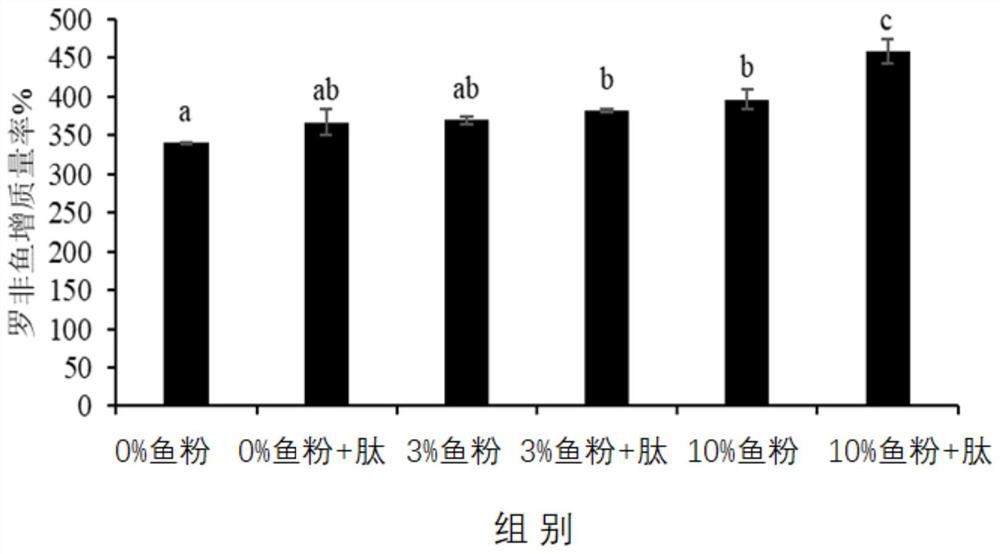Method for reducing dosage of fish meal in aquatic feed by adding ingestion growth regulating peptide
A technology for aquatic feed and growth regulation, applied in the field of polypeptide function research, can solve the problems of shortage of fish meal and increased cost of aquatic feed, etc.
- Summary
- Abstract
- Description
- Claims
- Application Information
AI Technical Summary
Problems solved by technology
Method used
Image
Examples
Embodiment 1
[0040] Example 1 Ingestion of Growth Regulating Peptide Spray Feed Technology
[0041] The ingestion growth regulating peptide was chemically synthesized, the purity was more than 95%, and its core amino acid sequence was YPVKPENPGED (the amino acid sequence is shown in SEQ ID NO: 1). The polypeptide feeding growth regulating peptide is added to the feed by spraying, and the method of preparing the spraying liquid and the spraying method are as follows:
[0042] (1) Take out the protein dry powder from the -80°C refrigerator and centrifuge it in a small centrifuge for 3 minutes. After the dry powder is completely placed at the bottom of the tube, slowly add 1 mL of double-distilled water along the tube wall, and fully vortex and centrifuge 3 times to prepare a concentration of is x mg / mL stock solution (placed at -20°C).
[0043] (2) Calculate the working fluid concentration according to the required amount. Taking a fish in each group, the average body weight is b kg, and t...
Embodiment 2
[0046] Example 2 The effect of feeding growth-regulating peptides on the growth of jellyfish fed with feeds with different fish meal content
[0047] 1. Experimental method
[0048]Two kinds of gem bass feeds containing 10% fish meal and 20% fish meal were prepared, and the total protein mass concentration of the two feeds was 40%. The feed formula is shown in Table 1. The ingested growth regulatory peptides were added to the feed by spraying as in Example 1.
[0049] Gem perch with a body weight of 14±2 grams and a uniform body weight were selected for grouping, and there were 4 treatments in total, namely, 10% fish meal by mass, 10% fish meal by mass + feeding growth regulating peptide, 20% fish meal by mass, and 20% fish meal by mass concentration. + ingestion of growth regulating peptides, each treatment set 3 replicates, a total of 12 groups, 100 fish in each group, fed with 10% fish meal group diet, the adaptation period was 14 days, the feeding amount was 4% of the bod...
Embodiment 3
[0075] Example 3 Effects of ingestion of growth-regulating peptides on the growth of tilapia fed with feeds with different fishmeal content
[0076] 1. Experimental method
[0077] Three tilapia feeds containing 0% fish meal, 3% fish meal and 10% fish meal were prepared, and the total protein mass concentration of the three feeds was 30%. The feed formulations are shown in Table 4. The ingested growth regulatory peptides were added to the feed by spraying as in Example 1.
[0078] Tilapia groups with a uniform body weight of 10±2 grams were selected, and there were 6 treatments in total, namely, 0% fish meal, 0% fish meal + feeding growth regulating peptide, 3% fish meal, and 3% fish meal + Feeding growth regulating peptide, 10% fish meal by mass concentration and 10% fish meal by mass concentration + feeding growth regulating peptide, each treatment set 3 replicates, a total of 18 groups, 100 tails in each group, fed with 0% fish meal group feed, given No feed additives wer...
PUM
 Login to View More
Login to View More Abstract
Description
Claims
Application Information
 Login to View More
Login to View More - R&D
- Intellectual Property
- Life Sciences
- Materials
- Tech Scout
- Unparalleled Data Quality
- Higher Quality Content
- 60% Fewer Hallucinations
Browse by: Latest US Patents, China's latest patents, Technical Efficacy Thesaurus, Application Domain, Technology Topic, Popular Technical Reports.
© 2025 PatSnap. All rights reserved.Legal|Privacy policy|Modern Slavery Act Transparency Statement|Sitemap|About US| Contact US: help@patsnap.com



